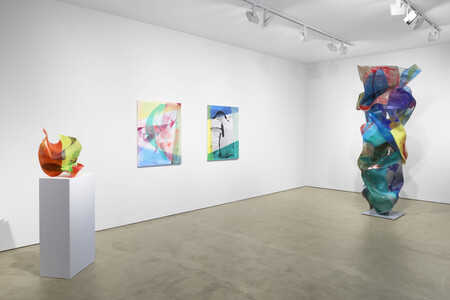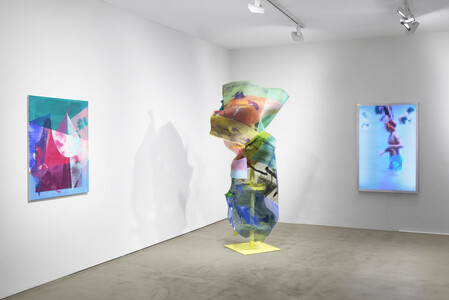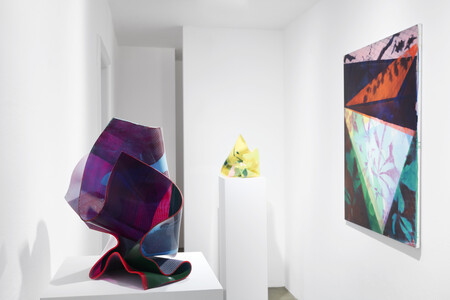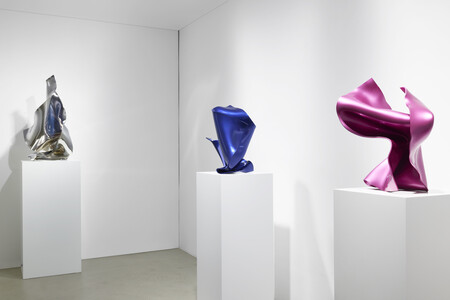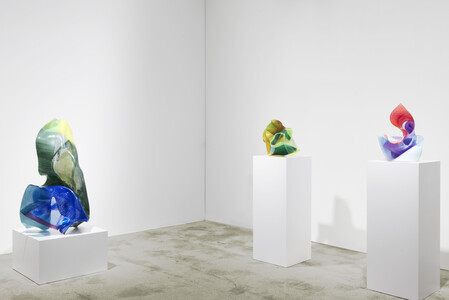HOW TO TALK WITH PENGUINS - Paul Schwer
Images of the Exhibition
Description
In his third exhibition at Galerie Wolfgang Jahn, Paul Schwer (*1951) presents new painterly and sculptural works in which he further unfolds the pictorial language he has been developing since the 1990s, positioned between painting, sculpture, and installation. The artist’s path is unusual: originally a physician in child and adolescent psychiatry, he turned to art in the early 1980s and studied at the Kunstakademie Düsseldorf with Erwin Heerich, eventually becoming his master student.
From an art-historical perspective, Schwer’s practice can be described as spatially expanded painting. Since the mid-2000s he has been working with painted, printed, and heated PET and Plexiglas panels, which he transforms into dynamic volumes. The result are translucent pictorial bodies, activated by color and light, that immediately incorporate the surrounding space. In this interweaving of color, material, and light, Schwer renews a line of color-space expansion dating back to the 1960s, though with a genuinely contemporary material aesthetic.
The exhibition title How to talk with Penguins brings together two strands of his oeuvre: the exploration of image resolution and the engagement with iconic motifs, which he transforms into painterly-sculptural overlays until they become unrecognizable. The point of departure is the work Antarctica (2024) for STOA169 in Polling, in which Schwer takes up the motif of the penguin. The figure can be read ambivalently: on the one hand as an iconically “cute” animal, on the other as a symbol of a fragile ecology threatened by the climate crisis. In Schwer’s treatment, the penguin undergoes a process of rastering, layering, and deformation, in which it loses its concrete shape and becomes an abstracted, “speaking” form—a form that tells less than it directly addresses perception itself.
Central to the exhibition are new, vertically bolted Plexiglas sculptures whose colorful stratifications and reflections evoke folds reminiscent of the Baroque. The sculptures oscillate between lightness and drama, between the serial placement of color and the spatial impact of sculptural bodies. New additions include small-scale sculptures with metallic, mirror-like surfaces that respond directly to their environment, as well as color-printed variations whose luminous cut edges emphasize the transition from plane into space.
Another group of works deepens the engagement with digital image culture. A lightbox and several canvases show pixelated figures, such as youths by the sea or penguins, whose source images come from the internet and are translated into both silkscreen and painterly processes. Using screen printing, spray, and grids, Schwer develops a visual language that both invokes and alienates the motif. While in his early work the figure remained clearly recognizable, in his current practice the grid appears as a visible trace of reproduction. It shifts the pictorial subjects toward abstraction and points to questions of resolution and media transformation. In this interplay of digital research and analog processing, a painterly combination emerges that remains as aesthetically seductive as it is critical of image consumption and habits of perception.
How to talk with Penguins presents Paul Schwer as a consistent explorer of the pictorial body in the age of digital transformation. Between net image and handwork, heat-formed matter and color space, grid and reflection, works emerge that do not illustrate but communicate—through light, material, and perception. The exhibition invites viewers to enter into dialogue with Schwer’s works and to reconsider the question: How does an image “speak” today—and to whom?
Text: Wilko Austermann
Photo credit: Produktion Pitz
